air condition MITSUBISHI ASX 2017 Owner's Manual (in English)
[x] Cancel search | Manufacturer: MITSUBISHI, Model Year: 2017, Model line: ASX, Model: MITSUBISHI ASX 2017Pages: 458, PDF Size: 22.98 MB
Page 6 of 458
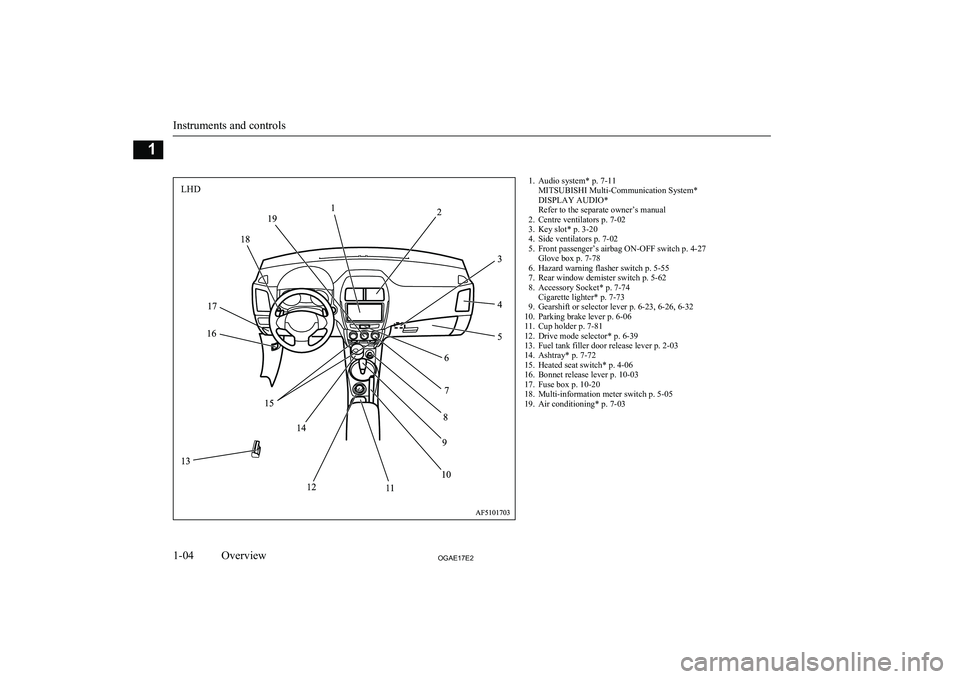
1. Audio system* p. 7-11MITSUBISHI Multi-Communication System*
DISPLAY AUDIO*
Refer to the separate owner’s manual
2. Centre ventilators p. 7-02
3. Key slot* p. 3-20
4. Side ventilators p. 7-02
5. Front passenger’s airbag ON-OFF switch p. 4-27 Glove box p. 7-78
6. Hazard warning flasher switch p. 5-55
7. Rear window demister switch p. 5-62
8. Accessory Socket* p. 7-74 Cigarette lighter* p. 7-73
9. Gearshift or selector lever p. 6-23, 6-26, 6-32
10. Parking brake lever p. 6-06
11. Cup holder p. 7-81
12. Drive mode selector* p. 6-39
13. Fuel tank filler door release lever p. 2-03
14. Ashtray* p. 7-72
15. Heated seat switch* p. 4-06
16. Bonnet release lever p. 10-03
17. Fuse box p. 10-20
18. Multi-information meter switch p. 5-05
19. Air conditioning* p. 7-03
Instruments and controls
1-04OGAE17E2Overview1LHD
Page 7 of 458
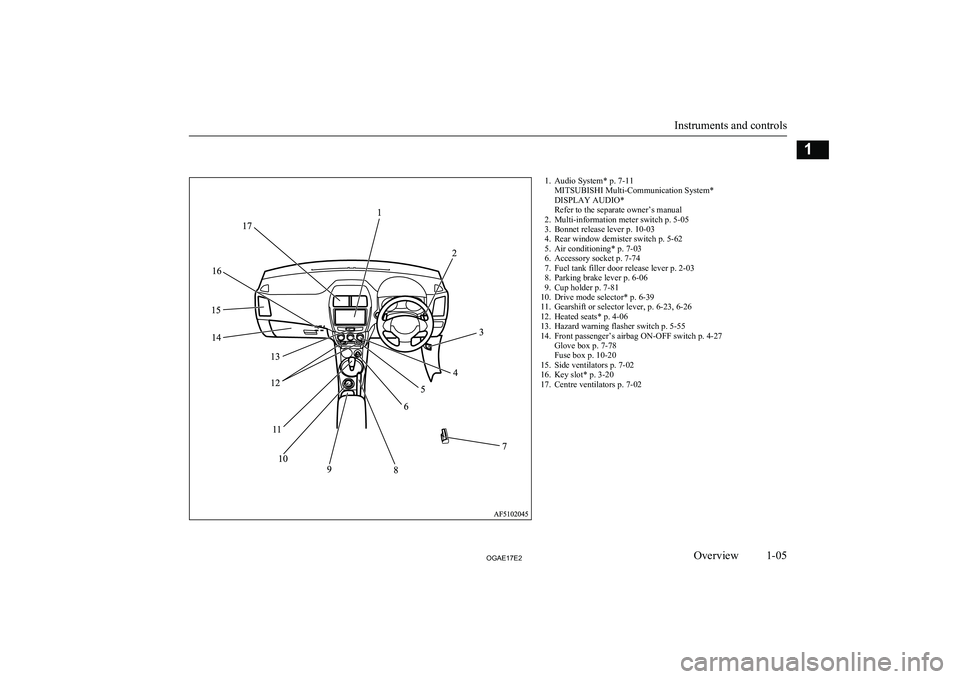
1. Audio System* p. 7-11MITSUBISHI Multi-Communication System*
DISPLAY AUDIO*
Refer to the separate owner’s manual
2. Multi-information meter switch p. 5-05
3. Bonnet release lever p. 10-03
4. Rear window demister switch p. 5-62
5. Air conditioning* p. 7-03
6. Accessory socket p. 7-74
7. Fuel tank filler door release lever p. 2-03
8. Parking brake lever p. 6-06
9. Cup holder p. 7-81
10. Drive mode selector* p. 6-39
11. Gearshift or selector lever, p. 6-23, 6-26
12. Heated seats* p. 4-06
13. Hazard warning flasher switch p. 5-55
14. Front passenger’s airbag ON-OFF switch p. 4-27 Glove box p. 7-78
Fuse box p. 10-20
15. Side ventilators p. 7-02
16. Key slot* p. 3-20
17. Centre ventilators p. 7-02
Instruments and controls
1-05OGAE17E2Overview1
Page 24 of 458
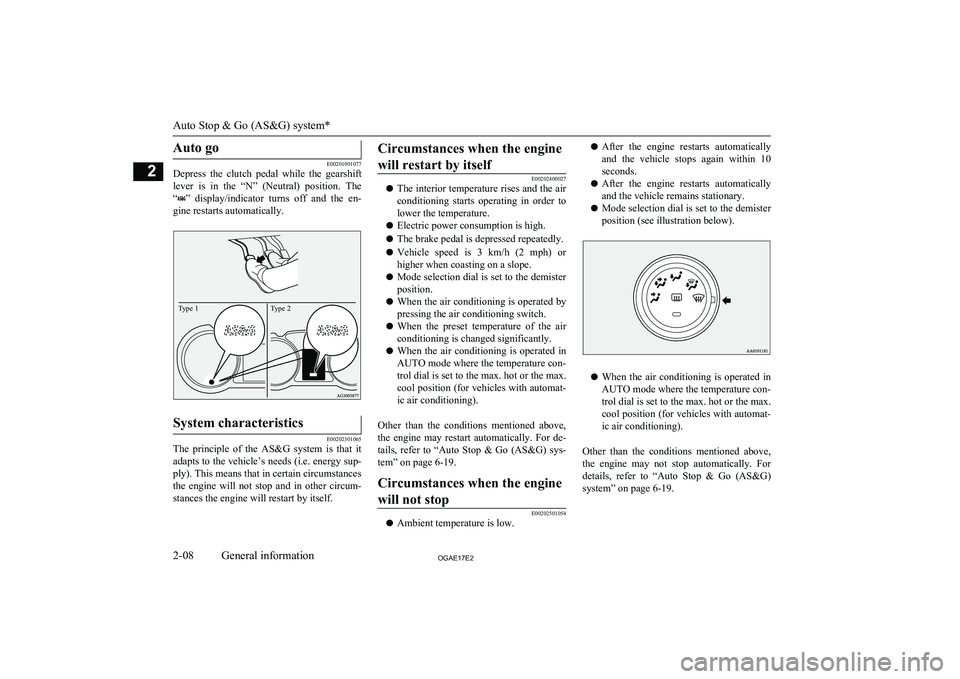
Auto go
E00201901077
Depress the clutch pedal while the gearshift
lever is in the “N” (Neutral) position. The
“
” display/indicator turns off and the en-
gine restarts automatically.
Type 2Type 1System characteristics
E00202301065
The principle of the AS&G system is that it
adapts to the vehicle’s needs (i.e. energy sup- ply). This means that in certain circumstancesthe engine will not stop and in other circum-
stances the engine will restart by itself.
Circumstances when the engine
will restart by itself
E00202400027
l The interior temperature rises and the air
conditioning starts operating in order to lower the temperature.
l Electric power consumption is high.
l The brake pedal is depressed repeatedly.
l Vehicle speed is 3 km/h (2 mph)
or
higher when coasting on a slope.
l Mode selection dial is set to the demister
position.
l When the air conditioning is operated by
pressing the air conditioning switch.
l When the preset temperature of the air
conditioning is changed significantly.
l When the air conditioning is operated in
AUTO mode where the temperature con-trol dial is set to the max. hot or the max.
cool position (for vehicles with automat- ic air conditioning).
Other than the conditions mentioned above, the engine may restart automatically. For de-
tails, refer to “Auto Stop & Go (AS&G) sys- tem” on page 6-19.
Circumstances when the engine
will not stop
E00202501054
l Ambient temperature is low.
lAfter the engine restarts automatically
and the vehicle stops again within 10
seconds.
l After the engine restarts automatically
and the vehicle remains stationary.
l Mode selection dial is set to the demister
position (see illustration below).
l When the air conditioning is operated in
AUTO mode where the temperature con-
trol dial is set to the max. hot or the max.
cool position (for vehicles with automat- ic air conditioning).
Other than the conditions mentioned above, the engine may not stop automatically. For details, refer to “Auto Stop & Go (AS&G)
system” on page 6-19.
Auto Stop & Go (AS&G) system*
2-08OGAE17E2General information2
Page 42 of 458
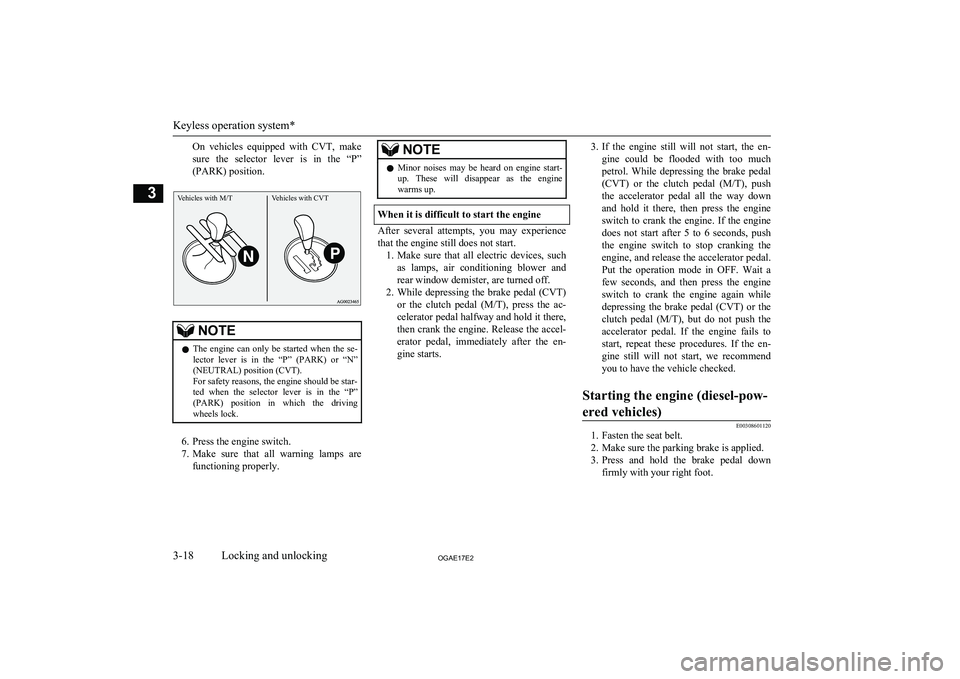
On vehicles equipped with CVT, make
sure the selector lever is in the “P”
(PARK) position.Vehicles with M/TVehicles with CVT
NOTEl The engine can only be started when the se-
lector lever is in the “P” (PARK) or “N” (NEUTRAL) position (CVT).
For safety reasons, the engine should be star-
ted when the selector lever is in the “P” (PARK) position in which the driving
wheels lock.
6. Press the engine switch.
7. Make sure that all warning lamps are
functioning properly.
NOTEl Minor noises may be heard on engine start-
up. These will disappear as the engine
warms up.
When it is difficult to start the engine
After several attempts, you may experience
that the engine still does not start. 1. Make sure that all electric devices, such
as lamps, air conditioning blower and
rear window demister, are turned off.
2. While depressing the brake pedal ( CVT)
or the clutch pedal ( M/T), press the ac-
celerator pedal halfway and hold it there, then crank the engine. Release the accel-erator pedal, immediately after the en-
gine starts.
3. If the engine still will not start, the en-
gine could be flooded with too much
petrol. While depressing the brake pedal (CVT ) or the clutch pedal ( M/T), push
the accelerator pedal all the way down and hold it there, then press the engine
switch to crank the engine. If the engine does not start after 5 to 6 seconds, push
the engine switch to stop cranking the
engine, and release the accelerator pedal. Put the operation mode in OFF. Wait a
few seconds, and then press the engine
switch to crank the engine again while
depressing the brake pedal ( CVT) or the
clutch pedal ( M/T), but do not push the
accelerator pedal. If the engine fails to
start, repeat these procedures. If the en-
gine still will not start, we recommend
you to have the vehicle checked.Starting the engine (diesel-pow-
ered vehicles)
E00308601120
1. Fasten the seat belt.
2. Make sure the parking brake is applied.
3. Press and hold the brake pedal down
firmly with your right foot.
Keyless operation system*
3-18OGAE17E2Locking and unlocking3
Page 80 of 458
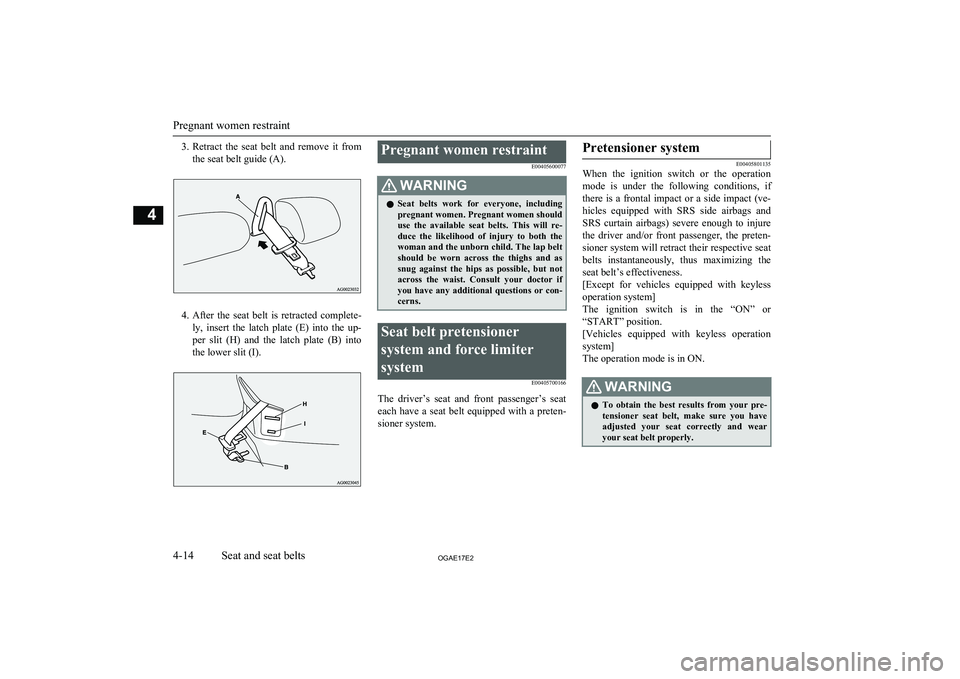
3.Retract the seat belt and remove it from
the seat belt guide (A).
4. After the seat belt is retracted complete-
ly, insert the latch plate (E) into the up-
per slit (H) and the latch plate (B) into the lower slit (I).
Pregnant women restraint
E00405600077WARNINGlSeat belts work for everyone, including
pregnant women. Pregnant women should
use the available seat belts. This will re- duce the likelihood of injury to both thewoman and the unborn child. The lap belt
should be worn across the thighs and as snug against the hips as possible, but not
across the waist. Consult your doctor if you have any additional questions or con-
cerns.Seat belt pretensioner
system and force limiter
system E00405700166
The driver’s seat and front passenger’s seateach have a seat belt equipped with a preten- sioner system.
Pretensioner system
E00405801135
When the ignition switch or the operation
mode is under the following conditions, if there is a frontal impact or a side impact (ve-
hicles equipped with SRS side airbags and SRS curtain airbags) severe enough to injure
the driver and/or front passenger, the preten-
sioner system will retract their respective seat belts instantaneously, thus maximizing the
seat belt’s effectiveness.
[Except for vehicles equipped with keyless operation system]
The ignition switch is in the “ON” or
“START” position.
[Vehicles equipped with keyless operation system]
The operation mode is in ON.
WARNINGl To obtain the best results from your pre-
tensioner seat belt, make sure you have adjusted your seat correctly and wear your seat belt properly.
Pregnant women restraint
4-14OGAE17E2Seat and seat belts4
Page 91 of 458
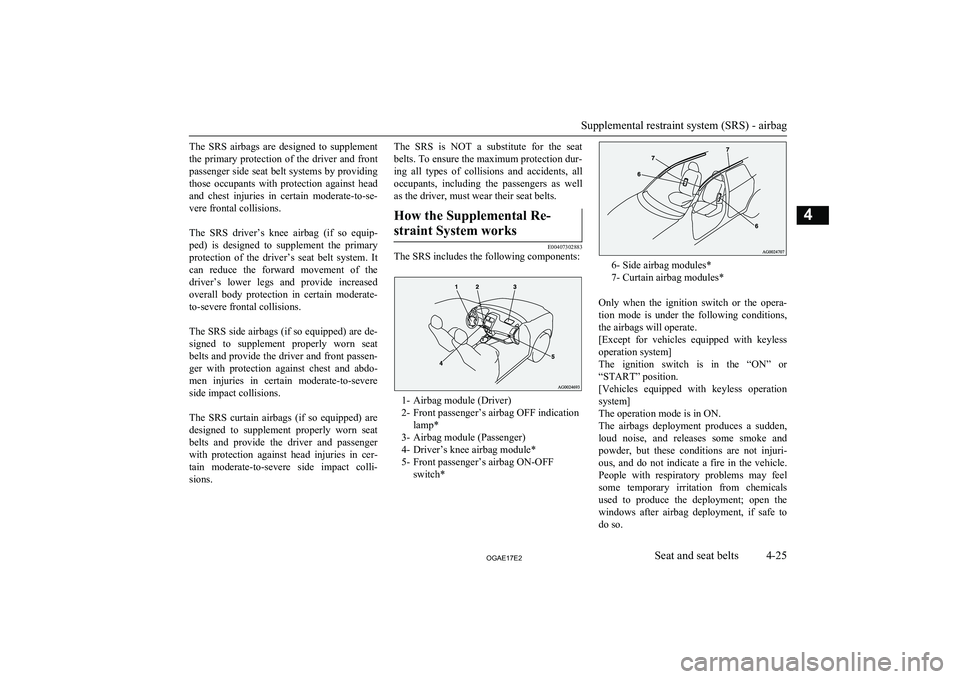
The SRS airbags are designed to supplementthe primary protection of the driver and front
passenger side seat belt systems by providing those occupants with protection against headand chest injuries in certain moderate-to-se- vere frontal collisions.
The SRS driver’s knee airbag (if so equip-
ped) is designed to supplement the primary
protection of the driver’s seat belt system. It can reduce the forward movement of the
driver’s lower legs and provide increased overall body protection in certain moderate-
to-severe frontal collisions.
The SRS side airbags (if so equipped) are de- signed to supplement properly worn seat belts and provide the driver and front passen-
ger with protection against chest and abdo-
men injuries in certain moderate-to-severe side impact collisions.
The SRS curtain airbags (if so equipped) are
designed to supplement properly worn seat belts and provide the driver and passenger with protection against head injuries in cer-
tain moderate-to-severe side impact colli- sions.
The SRS is NOT a substitute for the seat
belts. To ensure the maximum protection dur-
ing all types of collisions and accidents, all occupants, including the passengers as well
as the driver, must wear their seat belts.How the Supplemental Re-
straint System works
E00407302883
The SRS includes the following components:
1- Airbag module (Driver)
2- Front passenger’s airbag OFF indication lamp*
3- Airbag module (Passenger)
4- Driver’s knee airbag module*
5- Front passenger’s airbag ON-OFF switch*
6- Side airbag modules*
7- Curtain airbag modules*
Only when the ignition switch or the opera- tion mode is under the following conditions,
the airbags will operate.
[Except for vehicles equipped with keyless
operation system]
The ignition switch is in the “ON” or “START” position.
[Vehicles equipped with keyless operation
system]
The operation mode is in ON.
The airbags deployment produces a sudden,
loud noise, and releases some smoke andpowder, but these conditions are not injuri-
ous, and do not indicate a fire in the vehicle. People with respiratory problems may feel
some temporary irritation from chemicals
used to produce the deployment; open the
windows after airbag deployment, if safe to do so.
Supplemental restraint system (SRS) - airbag
4-25OGAE17E2Seat and seat belts4
Page 96 of 458
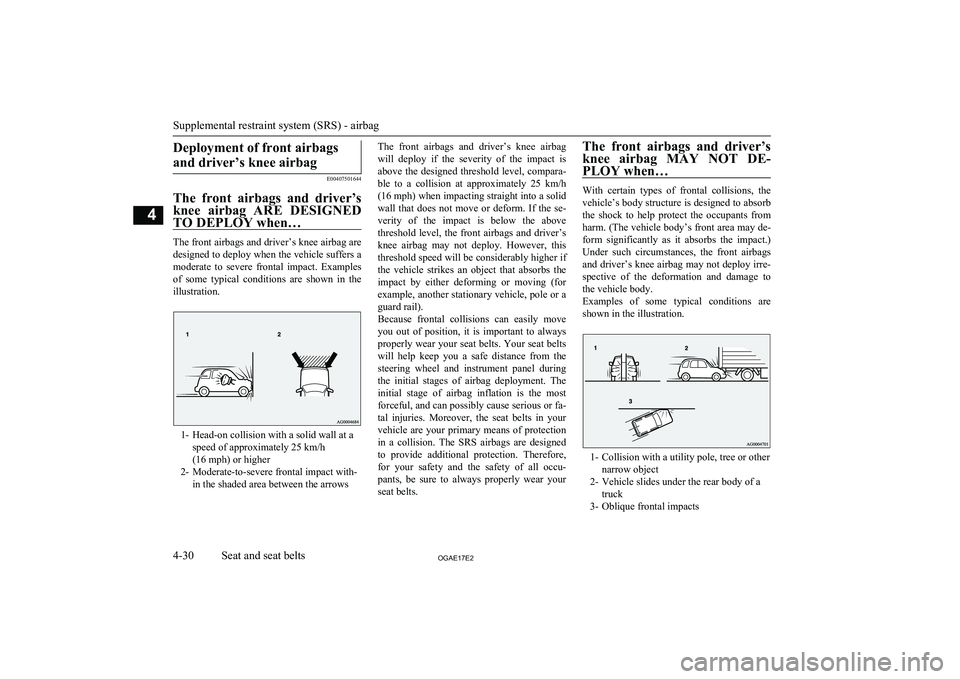
Deployment of front airbagsand driver’s knee airbag
E00407501644
The front airbags and driver’s knee airbag ARE DESIGNED
TO DEPLOY when…
The front airbags and driver’s knee airbag are
designed to deploy when the vehicle suffers a moderate to severe frontal impact. Examples
of some typical conditions are shown in the
illustration.
1- Head-on collision with a solid wall at a speed of approximately 25 km/h
(16 mph) or higher
2- Moderate-to-severe frontal impact with- in the shaded area between the arrows
The front airbags and driver’s knee airbag
will deploy if the severity of the impact is above the designed threshold level, compara-ble to a collision at approximately 25 km/h
(16 mph) when impacting straight into a solid
wall that does not move or deform. If the se-
verity of the impact is below the above threshold level, the front airbags and driver’s knee airbag may not deploy. However, this
threshold speed will be considerably higher if
the vehicle strikes an object that absorbs the impact by either deforming or moving (for
example, another stationary vehicle, pole or a
guard rail).
Because frontal collisions can easily move you out of position, it is important to always
properly wear your seat belts. Your seat belts will help keep you a safe distance from thesteering wheel and instrument panel during
the initial stages of airbag deployment. The
initial stage of airbag inflation is the most forceful, and can possibly cause serious or fa-tal injuries. Moreover, the seat belts in your
vehicle are your primary means of protection
in a collision. The SRS airbags are designed to provide additional protection. Therefore,
for your safety and the safety of all occu- pants, be sure to always properly wear your
seat belts.The front airbags and driver’s
knee airbag MAY NOT DE- PLOY when…
With certain types of frontal collisions, thevehicle’s body structure is designed to absorb
the shock to help protect the occupants from harm. (The vehicle body’s front area may de-form significantly as it absorbs the impact.) Under such circumstances, the front airbags and driver’s knee airbag may not deploy irre-
spective of the deformation and damage to
the vehicle body.
Examples of some typical conditions are shown in the illustration.
1- Collision with a utility pole, tree or other narrow object
2- Vehicle slides under the rear body of a truck
3- Oblique frontal impacts
Supplemental restraint system (SRS) - airbag
4-30OGAE17E2Seat and seat belts4
Page 97 of 458
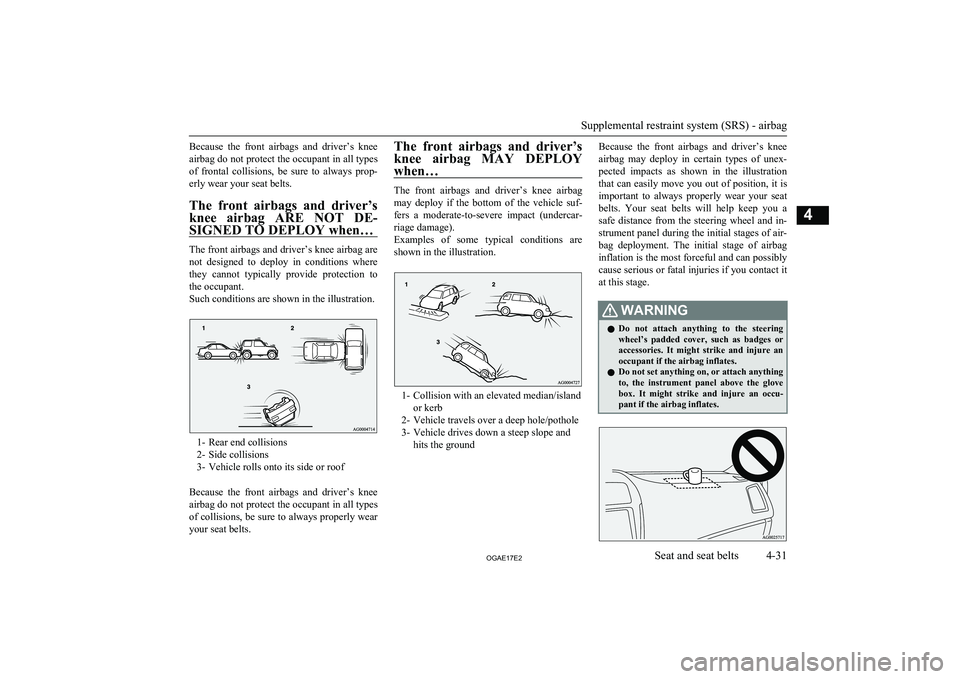
Because the front airbags and driver’s knee
airbag do not protect the occupant in all types of frontal collisions, be sure to always prop-erly wear your seat belts.
The front airbags and driver’s
knee airbag ARE NOT DE- SIGNED TO DEPLOY when…
The front airbags and driver’s knee airbag are
not designed to deploy in conditions where they cannot typically provide protection to
the occupant.
Such conditions are shown in the illustration.
1- Rear end collisions
2- Side collisions
3- Vehicle rolls onto its side or roof
Because the front airbags and driver’s knee
airbag do not protect the occupant in all types of collisions, be sure to always properly wearyour seat belts.
The front airbags and driver’s
knee airbag MAY DEPLOY
when…
The front airbags and driver’s knee airbag
may deploy if the bottom of the vehicle suf-
fers a moderate-to-severe impact (undercar- riage damage).
Examples of some typical conditions are shown in the illustration.
1- Collision with an elevated median/island or kerb
2- Vehicle travels over a deep hole/pothole
3- Vehicle drives down a steep slope and hits the ground
Because the front airbags and driver’s knee
airbag may deploy in certain types of unex- pected impacts as shown in the illustration that can easily move you out of position, it is important to always properly wear your seat belts. Your seat belts will help keep you a
safe distance from the steering wheel and in- strument panel during the initial stages of air-
bag deployment. The initial stage of airbag inflation is the most forceful and can possibly
cause serious or fatal injuries if you contact it
at this stage.WARNINGl Do not attach anything to the steering
wheel’s padded cover, such as badges or accessories. It might strike and injure an
occupant if the airbag inflates.
l Do not set anything on, or attach anything
to, the instrument panel above the glove box. It might strike and injure an occu- pant if the airbag inflates.
Supplemental restraint system (SRS) - airbag
4-31OGAE17E2Seat and seat belts4
Page 99 of 458
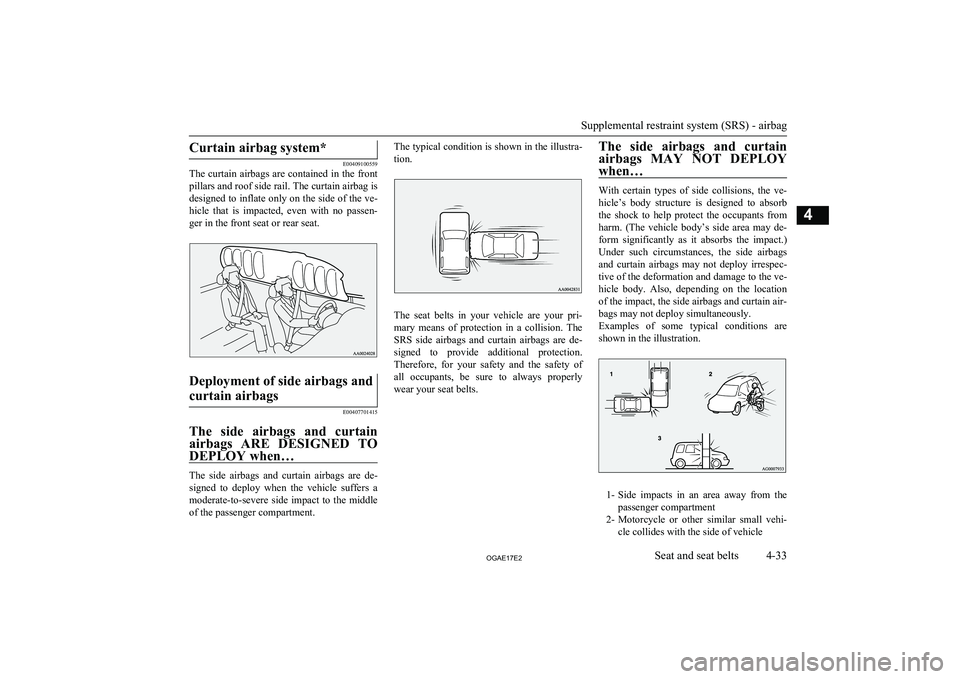
Curtain airbag system*
E00409100559
The curtain airbags are contained in the front
pillars and roof side rail. The curtain airbag is
designed to inflate only on the side of the ve- hicle that is impacted, even with no passen- ger in the front seat or rear seat.
Deployment of side airbags and
curtain airbags
E00407701415
The side airbags and curtain airbags ARE DESIGNED TO
DEPLOY when…
The side airbags and curtain airbags are de- signed to deploy when the vehicle suffers a moderate-to-severe side impact to the middleof the passenger compartment.
The typical condition is shown in the illustra-
tion.
The seat belts in your vehicle are your pri- mary means of protection in a collision. The SRS side airbags and curtain airbags are de-
signed to provide additional protection. Therefore, for your safety and the safety of all occupants, be sure to always properly
wear your seat belts.
The side airbags and curtain
airbags MAY NOT DEPLOY
when…
With certain types of side collisions, the ve- hicle’s body structure is designed to absorb
the shock to help protect the occupants from harm. (The vehicle body’s side area may de-form significantly as it absorbs the impact.) Under such circumstances, the side airbags and curtain airbags may not deploy irrespec-tive of the deformation and damage to the ve-
hicle body. Also, depending on the location
of the impact, the side airbags and curtain air-
bags may not deploy simultaneously.
Examples of some typical conditions are shown in the illustration.
1- Side impacts in an area away from the
passenger compartment
2- Motorcycle or other similar small vehi-
cle collides with the side of vehicle
Supplemental restraint system (SRS) - airbag
4-33OGAE17E2Seat and seat belts4
Page 100 of 458
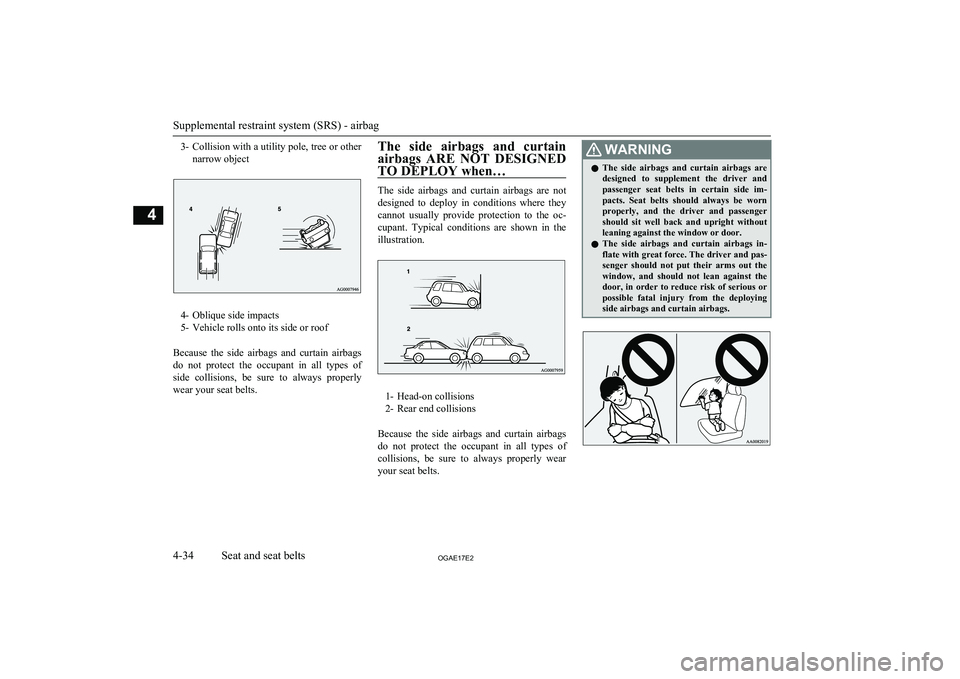
3-Collision with a utility pole, tree or other
narrow object
4- Oblique side impacts
5- Vehicle rolls onto its side or roof
Because the side airbags and curtain airbags do not protect the occupant in all types of side collisions, be sure to always properlywear your seat belts.
The side airbags and curtain
airbags ARE NOT DESIGNED TO DEPLOY when…
The side airbags and curtain airbags are notdesigned to deploy in conditions where they
cannot usually provide protection to the oc- cupant. Typical conditions are shown in the
illustration.
1- Head-on collisions
2- Rear end collisions
Because the side airbags and curtain airbags do not protect the occupant in all types of collisions, be sure to always properly wearyour seat belts.
WARNINGl The side airbags and curtain airbags are
designed to supplement the driver and passenger seat belts in certain side im-
pacts. Seat belts should always be worn properly, and the driver and passenger
should sit well back and upright without
leaning against the window or door.
l The side airbags and curtain airbags in-
flate with great force. The driver and pas-
senger should not put their arms out the window, and should not lean against the
door, in order to reduce risk of serious or
possible fatal injury from the deploying side airbags and curtain airbags.
Supplemental restraint system (SRS) - airbag
4-34OGAE17E2Seat and seat belts4